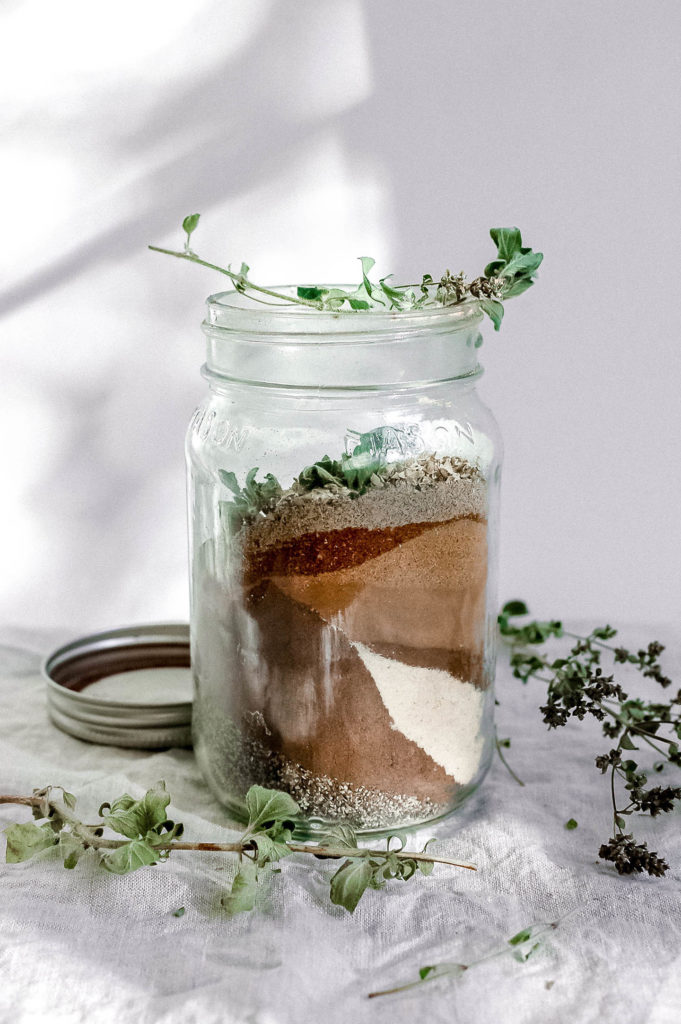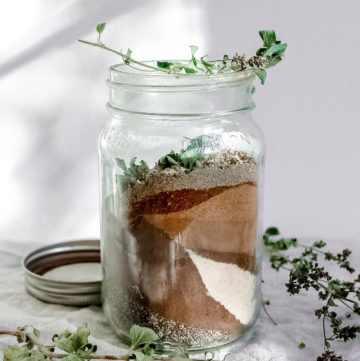
For me, one of the key constituents of what brings a great home cooked meal to life is spices. Make a big batch of this shawarma spice, and you can literally just sprinkle it onto whatever raw or cooked food you wish.
You don’t even need to make a special blend, but blends are fun, and whether it’s hot or mild… when you make your very own, you’re in the driver’s seat and have full control over what goes into it. Full of countless health benefits, antioxidants and anti-microbial (like food poisoning), anti-cancer and anti-inflammatory properties, I enjoy using spices in my simple cooking pretty much every day. To me, there is nothing more satisfying than throwing together a quick, simple, filling, energizing, and delicious meal that won’t taste like sadness and regret.
I’ve really been into shawarma spice lately, seasoning almost everything from roasted sprouted chickpeas to potato wedges to grass fed beef! It’s smoky and complex, and truly way better than anything store bought. Plus, when you make a huge batch of it from this recipe, it’ll last you forever. This recipe makes about a cup as shown in the photo, but you can double or triple the the recipe to make even more, or halve the recipe to make a smaller batch.
Traditionally, shawarma is made by placing marinated slabs of meat and fat on a vertical spit and roasting them slowly while turning the spit. The Arabic name shawarma actually has to do with the turning action of the spit. It comes from the Turkish word cevirme, which means turning. Shawarma is probably Turkish in origin, originally called doner kebab in Turkey, and eventually became known as shawarma as it spread throughout the Levant.
There is no singular shawarma blend that exists, but here’s my own take on the flavourful spice, with a nuanced and sweetly smoky flavour profile (without the nitrates, refined sugars, or additive riddled table salts). You can adjust it according to your preferences, as all spice blends are made for, anyways.
I recommend storing your spice blend in an air tight glass jar, such as a mason jar. Mason jars are a staple in my kitchen and I use them to store nearly everything from leftovers to ferments, dried goods, tea and other drinks, broths, and more. Click here to find some.
This particular shawarma spice blend can be used with:
- Grass fed, pasture raised kebabs or roasting: simply marinate lamb, fish, beef, chicken, sprouted organic tofu and tempeh, and more
- Curries
- Salads and Buddha bowls: add a bit to your dressing or sprinkle a little over your dish for a flavour kick
- Roasted sprouted chickpeas that go into said salad or Buddha bowl
- Baked crispy fries or potato wedges
- Pasture raised eggs
- As a garnish on hummus and tahini
- Roasted root vegetables that go into sandwiches

Ultimate Homemade Shawarma Spice
Ingredients
- 1/4 cup organic ground black pepper
- 1/4 cup organic ground allspice
- 1/4 cup organic garlic powder
- 2 tbsp organic ground cloves
- 2 tbsp organic ground Ceylon cinnamon
- 2 tbsp organic ground nutmeg
- 2 tbsp organic ground cardamom
- 1 tbsp organic ground chili powder
- 1 tbsp dried organic oregano leaves
- 1 tbsp sea salt
- 1 tsp organic ground cayenne
Instructions
- Combine all ingredients in a mason jar or other glass container. Stir or cover the jar with a lid and shake to thoroughly combine. Store in a cool, dry place.
Notes
- As with most spices, this tastes better the fresher it is, so try not to let it sit in storage for too long (it probably won’t be hard to as it’s so delicious). 6 month air tight storage in the pantry or a cool, dark place is recommended. If you’re in a humid climate, you can store it in the fridge.
- Toasting releases incredible dimensions of taste, so experiment with gently heating whole versions of the spices on a pan for about 5 minutes on medium low or until fragrant before adding them to a spice grinder, then using it in your favourite recipes.
- As healing and nourishing as grass fed, pasture raised red meat can otherwise be, burning meat can produce carcinogenic amines like benzopyrene so opt for cooking meat in soups/stews, or lightly enough to avoid burning, avoid the charring that creates the highest concentration of these compounds, and marinate with protective antioxidant herbs and spices like shawarma! Ancestors knew what they were doing!
- This spice goes particularly well with recipes using sweeter ingredients such as raw local honey, dates or maple syrup, or acidic flavours like lemon, grass fed kefir, or apple cider vinegar (such as in a tahini).
